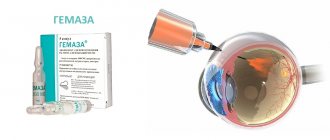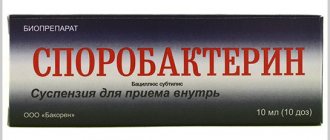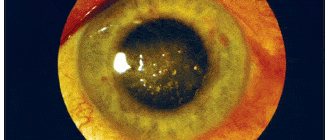Pharmacokinetics
When applied topically, cytochrome C is not absorbed into the blood and is completely metabolized in the body. The same metabolic pathways are involved in the destruction of cytochrome C as in the destruction of amino acids, and heme is broken down (biotransformed) into bilirubin, which is excreted in bile. Adenosine freely passes into the cornea and spreads throughout all tissues; T1/2 of adenosine from plasma is less than one minute, is metabolized in almost all tissues with the formation of inosine, xanthine and urate, which are freely excreted in the urine. Ribose is metabolized to glyceraldehyde-3-phosphate, then to pyruvate and burned in the Krebs cycle. Nicotinamide is rapidly absorbed and partially metabolized to nicotinic acid. Both of these compounds are converted to N-methylnicotinamide, which is further broken down in the liver. Metabolites and unchanged nicotinamide are excreted in the urine.
Pharmacological properties
Tissue repair stimulator, a combined agent whose action is aimed at improving the energy metabolism of the lens. The properties of the product are determined by the action of its constituent components:
Cytochrome C takes an active part in biochemical reactions and redox processes that occur in the eye tissues, being a powerful antioxidant.
Adenosine is a precursor of adenosine triphosphate (ATP), and it plays an important role in the metabolic processes of the lens.
Nicotinamide improves the production of nicotinamide dinucleotide (NAD), which is a cofactor for dehydrogenases.
Price
The cost of the medicine depends on the economic policy of pharmacy chains.
It is produced in France (Santen company) and Finland.
The drops are packaged in special plastic bottles of 10 ml. The solution in them has a red color and a uniform transparent consistency.
The product is sold in pharmacies at a price of 350-520 rubles.
special instructions
Patients who use soft contact lenses should not use Oftan Katahrom solution due to the presence of a preservative in its composition, which can be absorbed by them and have an adverse effect on the eye tissue.
Before using the drug, any contact lenses must be removed; they can be returned only after 15-20 minutes after instillation.
Patients who experience passing eye irritation after instillation of the drug should refrain from activities requiring high visual acuity (driving a car, working with potentially dangerous equipment) until the condition normalizes.
Store Oftan Katahrom tightly sealed at a temperature of 8-15°C. Not given to children.
The shelf life of the solution after opening the package is 1 month. The shelf life of an unopened bottle is 3 years.
How to use drops?
According to the instructions for use, instillation must be done in a lying position , throwing your head back and pulling the lower eyelid down with your finger.
It is better to instill oftan katachrome in the corner of the eye , slightly turning the head so that the medicine spreads over the surface of the conjunctiva in the direction of the temple on the same side as the eye being treated.
The procedure is repeated three times a day , it is necessary to instill one or two drops , and continue the course of treatment depending on the recommendations of the attending physician. As a rule, treatment does not take longer than two weeks.
If oftan katachrome is used for prophylaxis, the dosage can be increased to three drops.
But in this case, the use of the drug should also not exceed two weeks, and the course of treatment or preventive instillations can be repeated no earlier than after one week of abstaining from such drops.
Compound
The drops are three-component, so 1 ml. The drug contains: 675 mcg of cytochrome, 2 mg of adenosine, 20 mg of nicotinamide.
Cytochrome C
It is a strong antioxidant, based on an iron-containing chemical compound.
Adenosine
Natural substance - nourishes the lens and slows down its degeneration, accelerates energy metabolism at the cellular level, stimulates eye hydration processes, dilates blood vessels and improves local blood supply, treats inflammatory changes in the conjunctiva and cornea.
Nicotinomide
Once on the mucous membrane of the eye, it is converted into an important vitamin - nicotinic acid, which strengthens capillaries, helps to activate metabolism in the lens and remove waste substances from its cells.
Additional and preservative substances of catachrom are: sorbidol, sodium hydrogen phosphate dihydrate, distilled water, benzalkonium chloride, succinate hexahydrate.
The drops are stored unopened for 3 years; an open drug cannot be used for more than one month.
Analogs
- Taufon. One of the popular and well-selling products in Russia, it is used not only for the treatment of cataracts, but also for the correction of degenerative processes in the retina. The basis of the product is a sulfur-containing amino acid, which stimulates metabolic processes in the tissues of the eye. Drops are produced by a domestic pharmacological company, the price is 95-120 rubles.
- Slesin. The active component of this ophthalmic solution is a combination of dextran and hypromellose. They have a beneficial effect on energy reactions in the cells of the visual apparatus. Made in Romania, they cost 190-230 rubles.
- Visomitin . The base of the drops is a unique chemical substance synthesized in Russian laboratories. Plastoquinonyldecyltriphenylphosphonium bromide helps remove free radicals from damaged tissues and restore them. The price of drops ranges from 460 to 530 rubles.
Useful video
This video provides a short overview of Oftan Katahrom eye drops:
Oftan katachrome is a prescription medicine and therefore can only be used as prescribed by a doctor .
Even with cataracts , in which the condition is slightly alleviated during the use of the drug , you should not independently decide to instill this particular drug without a prior visit to a specialist.
Otherwise, there is a high probability of side effects and the development of additional ophthalmological pathologies against the background of the underlying disease.
Adverse reactions
Local
- burning, tingling, itching immediately after instillation;
- inflammatory processes in the conjunctiva or cornea (conjunctivitis, keratitis).
Are common
- disorders of the gastrointestinal tract (nausea, poor appetite, bloating, stool disorders);
- the appearance of a feeling of heat, dizziness, lack of air; loss of consciousness;
- arterial hypotension (low blood pressure), fainting.
Reviews
Gagarina Valentina Iosifovna, 58 years old:
These drops have helped me for many years, thanks to them I do not need cataract surgery. During the last course, the burning sensation after instillation was more disturbing, maybe the mucous membrane became more sensitive.
As for the rest, everything is fine - the clouding process does not develop further, the drops are always available for purchase, the price is normal, not exorbitant (I can afford it as a pensioner), the bottle is kept open for a month (enough for a course), it is convenient to use.
Irina, 44 years old:
I have clouding of the lens due to endocrine pathology. When I start dripping the drug, after a couple of days I see objects much better, which has a positive effect on my professional work and at home.
I noticed that the redness of the eyes disappeared and there was no dryness, apparently the drops also moisturize the mucous membrane. Side effects include mild tingling for a few minutes after instillation.
Ivan, 37 years old:
My mother uses Oftan; she has tried many remedies to fight cataracts. At one time I chose Taufon or Katahrom, which is better. She underwent courses of treatment for both. Taufon feels softer and stings less, but its effect is weaker (blurred vision often bothered me throughout the day). Katachrom is more stinging, but mom thinks that by dripping it, she sees better.
Well, my opinion is that since surgery is not offered, then the drops are working!
Features of drops
These eye drops, the harm and benefits of which are actively discussed on Internet portals, can have a negative effect in the following cases:
- their use and exceeding the dose without a doctor’s prescription;
- instillation into the eyes directly onto contact lenses, when the medicine is less absorbed and the lens quickly deteriorates;
- carrying out the procedure directly while driving a car, in these cases, temporary irritation of the eyes with the medicine can reduce visual acuity and cause an emergency situation on the road.
Treatment of cataracts with this remedy for pregnant women or nursing mothers is at the discretion of the doctor.
No negative reactions were detected when Oftan Katahroma was used together with other drops or medications.
In general, the drug inhibits the progression of cataracts, improves metabolic reactions in the tissues of the lens, expands small capillaries, improving blood flow in them.
Treatment with Katachrom is possible in any age category, the limitation is only in childhood and adolescence.
The use of Oftan Katachrom eye drops for the treatment of complicated cataracts in glaucoma
Lumpova T.N.
Usage of Oftan Catahrom eye drops
in treatment of glaucoma
TN Lumpova
Samara City Glaucoma Center
Purpose: to evaluate the clinical effectiveness of Oftan Catahrom eye drops in patients with cataract combined with glaucoma.
Materials and methods: There were 67 patients under observation: (120 eyes) with initial complicated cataract. Initial cataract was combined with primary open–angle glaucoma of stages I–II, compensated by medicamental treatment. All patients were prescribed Oftan Catahrom 3 times per day. Ophthalmologic examination included visometry, ophthalmoscopy, biomicroscopy, gonioscopy, perimetry, tonometry.
Period of observation lasted from 3 up to 5 years.
Results and conclusion: In 54% stabilization of the process, in 13% increase in visual acuity was registered in the long–term period. We can propose that Oftan Catahrom instillations both stop the cataract progression and contribute to resorption of lens opacity in some cases.
The term "cataract" comes from the Greek word "cataractos", which describes the boiling of water. The bubbling water becomes white and cloudy, like the lens of a mature cataract. According to the World Health Organization, 47% of cases of decreased visual acuity and blindness in the world are associated with cataracts. Between 85 and 93.2% of cataracts are classified as senile or age-related. The development of age-related cataracts can occur both in the cortical outer layers of the lens and in the nucleus, but more often affects both layers.
In patients with glaucoma, clouding of the lens occurs 1.5 times more often than in patients who do not suffer from it. Pathomorphological features of the lens in patients with primary open-angle glaucoma allow us to consider such cataracts as a special type of complicated cataract and justify the use of the term “glaucomatous cataract.”
With the long-term, gradual development of cataracts in glaucoma, proliferative mechanisms are included in the process. As a result, a rough fibrillar structure is formed under the posterior capsule. Therefore, at the early stages of prevention and treatment of cataracts in glaucoma, measures to prevent damage to the lens capsule are necessary (stabilization of ophthalmotonus, normalization of metabolic processes in the chambers of the eye, improvement of trophic processes). For this purpose, the use of drugs that delay the denaturation of lens proteins, as well as inhibit the photooxidation of lipid peroxides (Oftan Katahrom and other antioxidants), is indicated.
Complicated cataracts in the initial stage and so-called immature cataracts are characterized by a stable or progressive course. A regressive course, or resorption of cataracts, is theoretically possible, which is confirmed by many studies, but in life this does not happen as often as we would like. In this regard, stopping the progression of cataracts for years is already considered a great success. In complex fundamental studies, it was shown that the use of anti-cataract drugs makes it possible to some extent to stop the progression of lens opacities (I.A. Makarov, 2003). In the USA, it was estimated that if the development of cataracts was delayed by 10 years with the help of drugs, this would reduce the number of cataract operations performed annually by 45%. This is why the WHO supports the advisability of further large-scale studies of the effectiveness of drugs to prevent the development of cataracts, especially with the use of antioxidants (2001).
Modern anti-cataract drugs have a wide range of reparative effects, which allows them to be successfully used for the prevention of treatment of cataracts and metabolic lesions of other structures of the eye - the cornea, and, according to recent data, the retina. The following anti-cataract eye drops are currently in use in Russia:
• Vita-Iodurol (“Novartis Ophthalmics”, France)
• Oftan Katahrom (“Santen Oy”, Finland)
• Quinax (Alcon, USA).
Of these drugs, Oftan Katahrom is of greatest interest. Firstly, it has long been used in ophthalmic practice and is the most studied. Secondly, thanks to the complex action of its constituent components, it has an optimal effect in the treatment of metabolic eye diseases of any etiology.
The main pharmacological properties of the components of Oftan Katahrom drops:
– Cytochrome C is a high-molecular iron-containing compound that acts as a powerful antioxidant.
– Adenosine has multiple effects:
• is a nutrient and the main element for DNA repair and energy metabolism;
• nourishes the lens and cornea and helps flush out toxic decay products, stimulating the production and exchange of intraocular fluid. This occurs due to vasodilation and improved blood supply to the eyeball;
• reduces inflammation in the conjunctiva, cornea and other eye tissues, and also indirectly affects the restoration of glutathione, since it is a structural element of the enzyme glutathione reductase and reduced NADP, which are necessary to activate the main protective mechanism for suppressing oxidation processes (namely the reduction of glutathione) in the lens.
– Nicotinamide – in the tissues of the eye is converted into a vital vitamin – nicotinic acid, which increases capillary resistance and reduces their expansion, is necessary for tissue detoxification and intracellular nutrition with amino acids.
Clinical observations show that the use of Oftan Katachroma can stop the development of both cortical and posterior capsular cataracts for a long time. In some cases, complete resorption of the posterior capsular cataract was observed (G.S. Polunin et al., 2003).
We observed 67 patients (120 eyes) with initial complicated cataracts. There were 45 women, 22 men, aged from 41 to 82 years (average age - 65.1 years). Initial cataract was combined with primary open-angle glaucoma, grades I–II, medically compensated. All patients were recommended to instill Oftan Katahrom eye drops 3 times a day. Ophthalmological examination included visometry, biomicroscopy, gonioscopy, ophthalmoscopy, perimetry, Maklakov tonometry and non-contact tonometry. Slit-lamp examination assessed the transparency of anterior chamber moisture, posterior capsule opacities, and exfoliation on the surface of the anterior lens capsule. The degree of cataract development was assessed at the beginning and end of the study. The effectiveness of treatment was monitored by examining visual acuity without and with spectacle correction, questioning subjective sensations, and biomicroscopic examination of the lens.
The follow-up period was more than one year in 33 patients, more than two years in 29 patients, and more than 3 years in 5 patients.
Most patients noted a subjective improvement in vision without glasses and (or) with glasses by the end of the first year of treatment. Some patients exchanged positive glasses for smaller ones. In 3 patients, vision improvement was noted during the first months of treatment, and subsequently there was a decrease in vision to the initial state. At the end of the course of treatment, corrected visual acuity remained unchanged (did not worsen) in 65 eyes, which was 54% (first group of patients).
In the second group: visual acuity improved in 16 eyes (13.34%), of which 7 eyes had corrected vision. In 6 eyes with normal visual acuity in glasses, vision without correction improved by 0.2 (3 eyes) and 0.4 (3 eyes). However, corrected vision remained the same (1.0). On average, visual acuity in the second group increased from 0.71 to 0.83. However, it was not possible to provide an objective assessment of the improvement in visual acuity. We can only assume that some patients experience regression in lens opacification under the influence of Oftan Katachroma instillations.
In the third group of patients, in 36 eyes, which is 30%, corrected visual acuity worsened. We do not exclude the possibility that in the future (in 5–10 years or less) in some of these patients, the initial cataract will develop into an immature or mature stage, in which drug treatment is powerless and surgical intervention will be required.
In conclusion, I would like to emphasize that to prevent the progression of glaucomatous cataracts, it is important to exclude changes in intraocular pressure, which is achieved by a clearly balanced regimen of using antihypertensive drugs.
conclusions
1. Most patients with initial cataracts note a subjective improvement in vision after several months of instillation of Oftan Katachroma.
2. In the long term, the majority of patients (54% of eyes) experienced stabilization of the process, and in 13% of cases, visual acuity increased.
3. It can be assumed that instillations of Oftan Katachroma not only slow down and stop the progression of initial cataracts, but also contribute to the partial resorption of lens opacities in some patients.
Literature
1. Kurysheva N.I. // Glaucoma: Collection of scientific papers, – M., 1994 – P. 162 –168.
2. Kurysheva N.I., Vinetskaya M.I., Erichev V.P. et al. // Vestn. ophthalmol. – 1998. – 1 – P. 10–13.
3. Polunin G.S. //Consilium Medicum, Ophthalmology, 2001, pp. 9–10.
4. Shmeleva V.V. Cataract. M., “Medicine”, 1981.
The article was accepted for publication on August 30, 2007.







